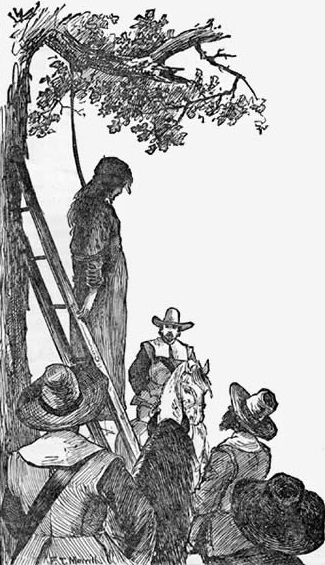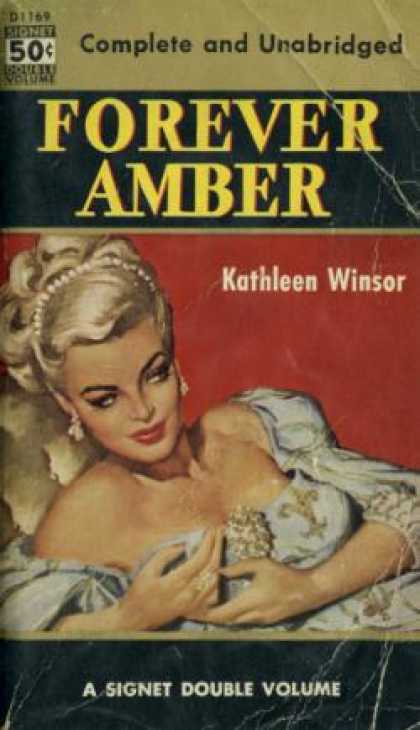Alse Young Hanged for Witchcraft, 1647
Alse Young is believed to be the first person executed for witchcraft in the American colonies. The records of her trial are exceedingly sketchy, consisting of two separate entries in two journals. John Winthrop, the governor of Massachusetts, made an entry in his journal that day, "One [blank] of Windsor arraigned and executed at Hartford for a witch." He left a blank for the name; presumably either he didn't know or couldn't remember it. The other entry was by the second town clerk of Windsor, Matthew Grant, "May 26, 47. Alse Young was hanged."There is no other record of the execution, and, until the two entries were put together some 200 years later, the identity of the hanged "witch" was not known. We don't know why she was accused. There seems to have been some kind of outbreak of disease early in 1647, and that may have been a factor. It has also been suggested that Alse's real "crime" was that she hadn't produced a male heir, making her eligible to inherit her husband's property -- a failure she shared with Mary Johnson, Margaret Jones, Joan Carrington, and Mary Parsons, all of whom were executed for witchcraft in the late 1640's and early 1650's.
Whatever the reason, Alse was hung in Hartford, Connecticut in 1647, 45 years before the Salem Witch Trials took place. Shortly thereafter, Alse's husband and daughter unsurprisingly moved out of the area.
It is interesting to note that Alse's daughter, Alice Young Beaumon, was also accused of witchcraft in Springfield, Massachusetts, some 30 years later. Alice Beaumon, however, escaped her mother's ultimate fate.
Pauline Parker Born, 1938
Pauline Parker was a 16-year old girl living in New Zealand in 1954. Like most 16-year-olds, she had a best friend, Juliet Hulme, also 16. Their friendship was a little unusual, though, bordering on the obsessive. They wrote adventure novels together, which they hoped to sell in Hollywood for a series of films. They invented their own religion, complete with saints and its own code of morality. They talked about the "Fourth World," a sort of spiritual Nirvana that they were able to enter occasionally. Their parents were concerned.At about this time, Juliet discovered that her mother was having an affair, and that her parents were separating and planning a divorce. Mr. Hulme was planning on relocating to South Africa. The parents thought that this would provide a fine opportunity to separate the girls, whom they thought were becoming a little too close. They were concerned primarily about the possibility of homosexual tendencies, which at the time were considered to be a type of mental illness.
The plan was for Juliet to accompany her father to South Africa, leaving Pauline behind. Both girls wanted Pauline to go with Juliet when she left New Zealand, but Pauline's mother was determined that her daughter would not go with her friend. The girls had a solution: they would murder Mrs. Parker.
The girls lured Mrs. Parker to a remote area in Victoria Park. Juliet dropped an ornamental stone and Mrs. Parker bent over to pick it up. Pauline then hit her mother on the head with a brick wrapped in a stocking. The girls had imagined that the act would kill her instantly, but it took 45 frenzied blows to kill the woman. The girls then ran back to the tea shop where they had just dined with Mrs. Parker, and told the owners that Pauline's mother had fallen and hit her head. The condition of the body, as well as the discovery of the murder weapon, quickly disproved their story.
The girls were found guilty on August 30, 1954. Each of them spent five years in prison and were then released, on the condition that they never see each other again. Pauline Parker moved to England, where she opened a children's riding school and converted to Roman Catholicism. Juliet Hulme joined the Church of Jesus Christ of the Latter Day Saints, and eventually settled in Scotland. She now writes historical detective novels under the name of Anne Perry.
Death of Kathleen Winsor, 2003
At the age of 17, Kathleen Winsor, a student at the University of California, Berkeley, married a fellow student, Robert Herwig. Herwig was an All-American football player, and was writing an honors thesis paper of Charles II. One day, out of boredom, Kathleen read one of his books.The subject fascinated Winsor and she eventually read 356 books on the subject. She then started writing her novel.
Her fifth draft of Forever Amber was accepted for publication by Macmillan, the same firm that had made a best-seller out of Gone with the Wind. They quickly edited Amber down to 972 pages -- one-fifth of its original length.
Forever Amber is set during the Restoration Period in England, and Winsor was greatly influenced by her reading, especially the vivid descriptions of the plague and the London Fire written by Daniel Defoe and Samuel Pepys. The book is best known, however, for its rollicking sex scenes.
Fourteen states banned the book under pornographic guidelines. The attorney general of Massachusetts (the first state to ban it) cited 70 depictions of sexual intercourse, 39 illegitimate pregnancies, 7 abortions, and "10 descriptions of women undressing in front of men." Winsor herself said, however, that her book wasn't particularly graphic. "I only wrote two sexy passages, and my publishers took both of them out. They put in ellipses instead. In those days, you know, you could solve anything with an ellipsis."
Naturally, all the adverse publicity made the book an immediate best-seller. It sold over 100,000 copies in the first week of its release, and eventually over three million copies. Forever Amber became the best-selling book of the 1940's.


No comments:
Post a Comment